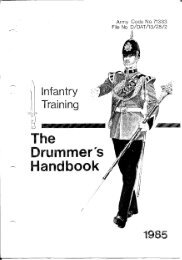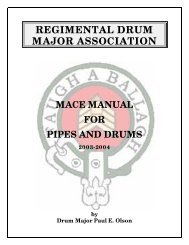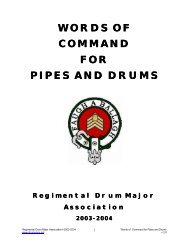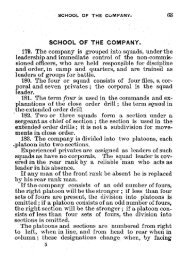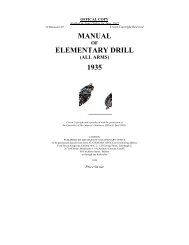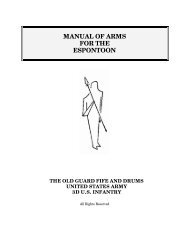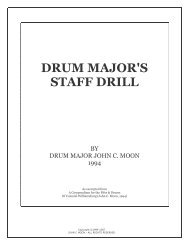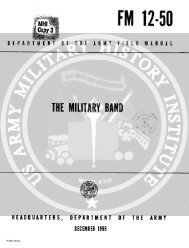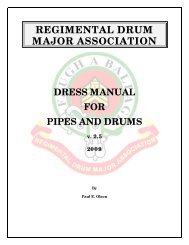Marine corps drill and ceremonies manual - Regimental Drum Major ...
Marine corps drill and ceremonies manual - Regimental Drum Major ...
Marine corps drill and ceremonies manual - Regimental Drum Major ...
Create successful ePaper yourself
Turn your PDF publications into a flip-book with our unique Google optimized e-Paper software.
1-2. DRILL INSTRUCTORS<br />
Training personnel in <strong>drill</strong> is an important duty. From the<br />
beginning of his career, each officer <strong>and</strong> noncommissioned officer should<br />
take pride in being considered an efficient <strong>drill</strong> instructor. If he knows<br />
the <strong>drill</strong> regulations <strong>and</strong> how to instruct, he will gain the respect <strong>and</strong><br />
confidence of those he comm<strong>and</strong>s.<br />
a. In addition, a good <strong>drill</strong> instructor must:<br />
(1) Follow regulations strictly, as an example to the <strong>Marine</strong>s<br />
under instruction.<br />
(2) Have energy, patience, <strong>and</strong> spirit.<br />
(3) Have military neatness <strong>and</strong> bearing.<br />
(4) Watch his <strong>Marine</strong>s constantly, immediately correcting any<br />
mistakes noted.<br />
b. When the instructor corrects a movement, the individual or unit<br />
should immediately be required to repeat the movement properly. Troops<br />
should be reprim<strong>and</strong>ed only as a last resort. Officers <strong>and</strong> noncommissioned<br />
officers should not be reprim<strong>and</strong>ed in the presence of subordinates.<br />
c. Before a <strong>drill</strong> period, an instructor should thoroughly study the<br />
movements to be executed.<br />
d. The instructor’s post is that of the comm<strong>and</strong>er. The instructor<br />
may place himself wherever he can best control the troops, make<br />
corrections, <strong>and</strong> ensure proper performance.<br />
e. The instructor briefly explains <strong>and</strong> demonstrates each new movement<br />
prior to its execution by the troops. The troops should take proper<br />
positions unassisted. The instructor touches them only when absolutely<br />
necessary. Each position or movement must be thoroughly understood before<br />
another is attempted.<br />
f. Drill periods should be short but frequent. Snap should be<br />
required in every movement.<br />
1-3. INSTRUCTION GROUPS<br />
a. The basic instruction group is the squad. Its size facilitates<br />
individual instruction (see chapter 7).<br />
b. <strong>Marine</strong>s who learn slowly should be placed in special squads. Such<br />
squads should be <strong>drill</strong>ed by the best instructors available. These <strong>Marine</strong>s<br />
should not be ridiculed.<br />
1-4. COMMANDS AND THE COMMAND VOICE<br />
a. There are two types of comm<strong>and</strong>s. The first, the preparatory<br />
comm<strong>and</strong>--such as FORWARD--indicates a movement is to be made. The second,<br />
the comm<strong>and</strong> of execution--such as MARCH--causes the desired movement to be<br />
made. In some comm<strong>and</strong>s, such as FALL IN, AT EASE, <strong>and</strong> REST, the<br />
preparatory comm<strong>and</strong> <strong>and</strong> the comm<strong>and</strong> of execution are combined.<br />
b. In this <strong>manual</strong>, preparatory comm<strong>and</strong>s are shown in CAPITAL LETTERS<br />
<strong>and</strong> comm<strong>and</strong>s of execution in UNDERLINED CAPITAL LETTERS. When movements<br />
by the numbers are discussed, the count in parentheses precedes the<br />
discussion.<br />
1-6



